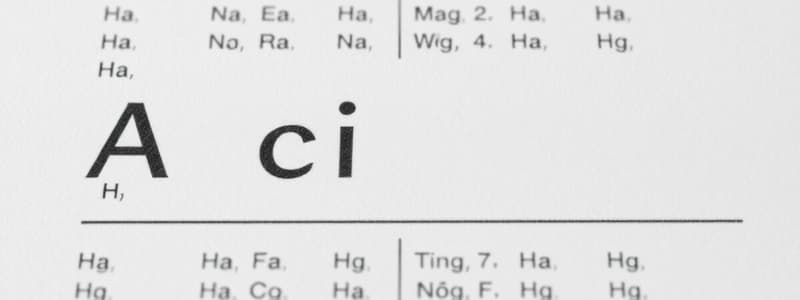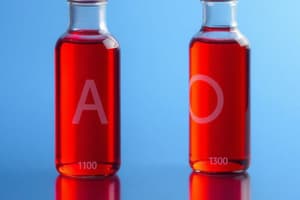Podcast
Questions and Answers
What is the correct name for the compound HgCl2?
What is the correct name for the compound HgCl2?
- mercury (II) chloride (correct)
- mercury dichloride
- tetrahydromercury chloride
- mercury (I) chloride
Which of the following names corresponds to the compound Ca(OH)2?
Which of the following names corresponds to the compound Ca(OH)2?
- calcium dihydroxide
- calcium hydroxide (correct)
- calcium oxide
- calcium water
Which of the following represents a trivial name for a compound?
Which of the following represents a trivial name for a compound?
- dihydrogen monoxide
- sodium chloride
- water (correct)
- calcium bicarbonate
What is the correct naming for K2Cr2O7?
What is the correct naming for K2Cr2O7?
Which compound is referred to as 'baking soda'?
Which compound is referred to as 'baking soda'?
What distinguishes peroxides from normal oxides?
What distinguishes peroxides from normal oxides?
Which of the following compounds contains a polyatomic ion?
Which of the following compounds contains a polyatomic ion?
What is the systematic name for the compound NH3?
What is the systematic name for the compound NH3?
What is the correct name for the compound SO2?
What is the correct name for the compound SO2?
Which of the following is the correct formula for Tin (IV) Chloride?
Which of the following is the correct formula for Tin (IV) Chloride?
Identify the correct formula for Calcium Phosphate.
Identify the correct formula for Calcium Phosphate.
What is the correct name for the acid with the formula H2SO4?
What is the correct name for the acid with the formula H2SO4?
What is the name of the sodium salt for the binary acid HBr?
What is the name of the sodium salt for the binary acid HBr?
What is the correct formula for Ammonium Phosphate?
What is the correct formula for Ammonium Phosphate?
Which of the following compounds is represented by the formula PbS2?
Which of the following compounds is represented by the formula PbS2?
What is the correct name for the compound CF4?
What is the correct name for the compound CF4?
What is the correct name for the compound represented by the formula P2S5?
What is the correct name for the compound represented by the formula P2S5?
Which of the following is the correct formula for chlorine trifluoride?
Which of the following is the correct formula for chlorine trifluoride?
What is the correct formula for radium acetate?
What is the correct formula for radium acetate?
What is the correct name for the compound with the formula Fe(OH)3?
What is the correct name for the compound with the formula Fe(OH)3?
Which formula corresponds to silver dichromate?
Which formula corresponds to silver dichromate?
What is the formula for strontium carbonate?
What is the formula for strontium carbonate?
How is lithium bismuthate chemically represented?
How is lithium bismuthate chemically represented?
What is the correct name for the compound Na2S4O6?
What is the correct name for the compound Na2S4O6?
What is the formula for ammonium molybdate?
What is the formula for ammonium molybdate?
What is the correct name for mercury (II) ferricyanide?
What is the correct name for mercury (II) ferricyanide?
What prefix is used for binary acids in aqueous solutions?
What prefix is used for binary acids in aqueous solutions?
Which of the following is the correct naming for H2S in aqueous solution?
Which of the following is the correct naming for H2S in aqueous solution?
What is the suffix for the non-metallic anion when naming salts?
What is the suffix for the non-metallic anion when naming salts?
Which of the following correctly describes the naming system for ferrous chloride?
Which of the following correctly describes the naming system for ferrous chloride?
What does the stock system utilize to indicate the oxidation state of elements?
What does the stock system utilize to indicate the oxidation state of elements?
Which of these compounds is correctly named as magnesium bromide?
Which of these compounds is correctly named as magnesium bromide?
Which statement about Greek prefixes is true for naming salts?
Which statement about Greek prefixes is true for naming salts?
In the OUS – IC naming system, what suffix is applied to the ion with a higher oxidation state?
In the OUS – IC naming system, what suffix is applied to the ion with a higher oxidation state?
Which of the following anions has a -1 charge?
Which of the following anions has a -1 charge?
What is the chemical formula for the acetate anion?
What is the chemical formula for the acetate anion?
Which anion has a -2 charge?
Which anion has a -2 charge?
Identify the anion with a -3 charge from the following options.
Identify the anion with a -3 charge from the following options.
What is the formula for hydrogen sulfate?
What is the formula for hydrogen sulfate?
Which of the following anions does NOT have a charge of -2?
Which of the following anions does NOT have a charge of -2?
What is the charge of the bromate anion?
What is the charge of the bromate anion?
Which anion is represented by the formula NO2-?
Which anion is represented by the formula NO2-?
Flashcards are hidden until you start studying
Study Notes
Chemical Nomenclature
- Chemical Compounds are named using a systematic approach based on their chemical formula, which indicates the types of elements and their quantities in the compound, and how they are bonded.
- Binary Compounds are formed by two elements (nonmetals) and their names are created by using the name of the first element (with a Greek prefix denoting the number of atoms of that element) and the name of the second element with the suffix "-ide".
Naming Acids and Salts
- Binary Acids are formed by dissolving nonmetallic hydrides in water. Their names are formed by using the prefix "hydro-", a root for the second element, and the suffix"-ic", followed by "acid".
- Salts are ionic compounds that are formed by the reaction of an acid with a base. Their names are formed by combining the cation (positive ion) from the base and the anion (negative ion) from the acid.
- Polyatomic Ions are groups of atoms that carry a net charge. Compounds that contain polyatomic ions are named according to the same rules as simple ionic compounds.
Prefix System
- Prefixes are used to indicate the number of atoms of each element.
- Greek prefixes are used for both ionic and covalent compounds.
- Roman numeral prefixes are used for compounds containing metals with variable valences, to indicate the oxidation state of the metal.
Examples of Compounds and Their Names
- Diphosphorus Pentasulfide: P2S5
- Chlorine Trifluoride: ClF3
- Radium Acetate: Ra(CH3COO)2
- Iron (III) Hydroxide: Fe(OH)3
- Silver Dichromate: Ag2Cr2O7
- Strontium Carbonate: SrCO3
- Lithium Bismuthate: LiBiO3
- Sodium Tetrathionate: Na2S4O6
- Ammonium Molybdate: (NH4)2MoO4
- Mercury (II) Ferricyanide: Hg3[Fe(CN)6]2
- HI (aq): Hydroiodic Acid
- HF (aq): Hydrofluoric Acid
- HIO (aq): Hypoiodous Acid
- HIO2 (aq): Iodous Acid
- HIO3 (aq): Iodic Acid
- HIO4 (aq): Periodic Acid
- H3AsO4 (aq): Arsenic Acid
- H3AsO3 (aq): Arsenous Acid
- HNO3 (aq): Nitric Acid
- HNO2 (aq): Nitrous Acid
Note:
- The text provides several examples of chemical compounds and their names. Each compound is categorized based on its chemical formula and the rules for naming it.
- Students will need to understand the different categories of compounds and the systematic rules for naming them. They will also need to be able to write the chemical formula of a compound given its name, and vice versa.
How to Study
- Read the text carefully, paying attention to the different naming rules.
- Practice writing the chemical formulas for the compounds listed in thetext.
- Practice naming the compounds given their chemical formulas.
- Use the appendix as a resource for identifying common anions.
Key Points for the Appendix Material
- The appendix provides a list of common anions (negative ions) used in chemical nomenclature.
- -1 charge anions include hydride, fluoride, chloride, bromide, iodide, cyanide, cyanate, thiocyanate, hydroxide, amide, acetate, formate, nitrate, nitrite, perchlorate, chlorate, chlorite, hypochlorite, iodate, bromate, hypobromite, permanganate, dihydrogen phosphate, hydrogen sulfate, and bicarbonate.
- -2 charge anions include oxide, sulfide, sulfate, thiosulfate, sulfite, peroxide, hydrogen phosphate, chromate, dichromate, and carbonate.
- -3 charge anions include nitride, phosphate, arsenate, and arsenite.
Studying That Suits You
Use AI to generate personalized quizzes and flashcards to suit your learning preferences.




